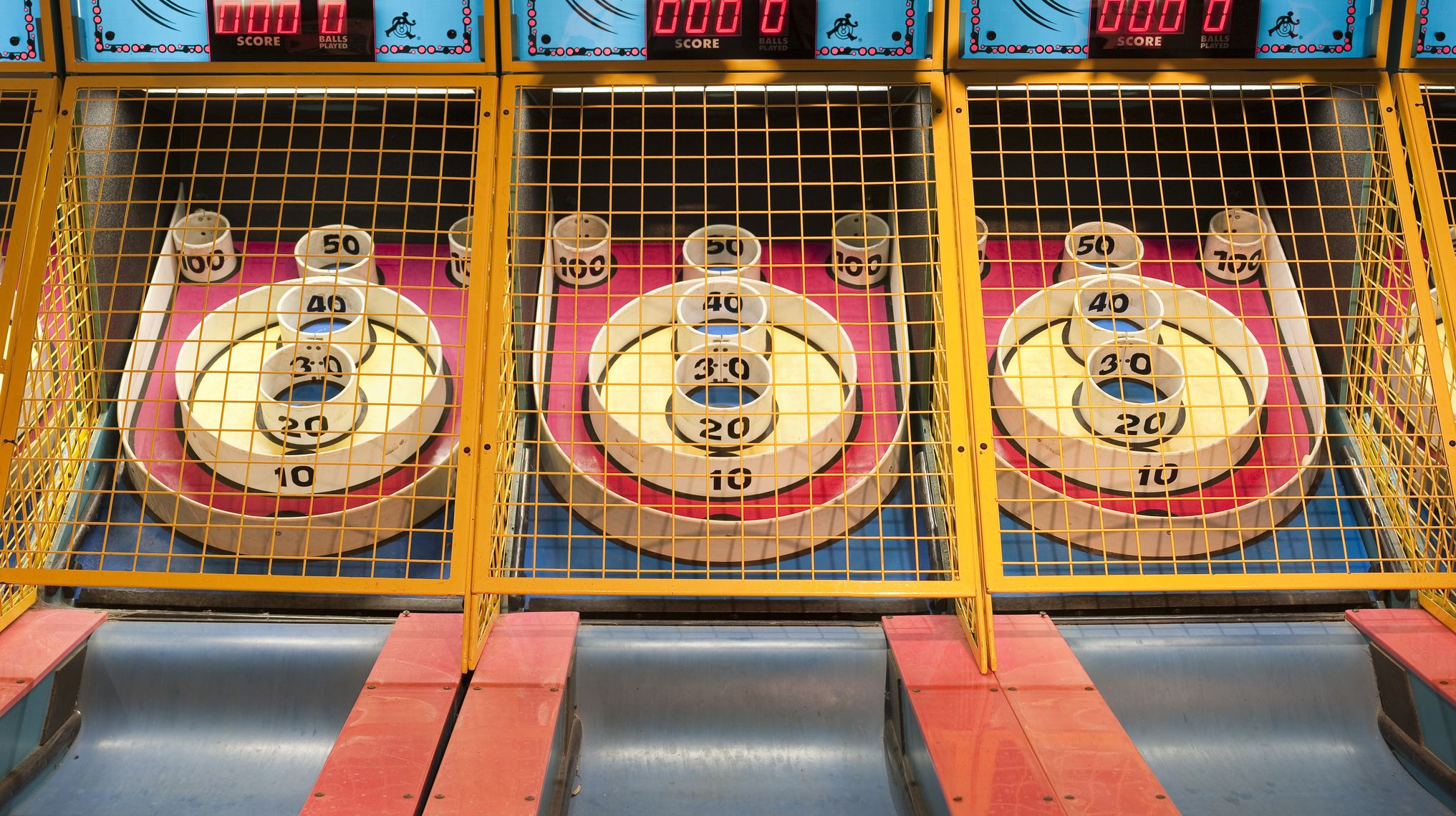
On December 8, 1908, a little more than a year after submitting his application, Joseph Fourestier Simpson was granted a patent for a “game apparatus.” Simpson’s contraption featured a long alley where players rolled “small moving bodies” up an inclined plane, with various point values awarded, depending on where the small moving body—usually a ball—landed.
Though Simpson saw little financial benefit from his creation, people have been playing Skee-Ball ever since. There’s even a competitive circuit that awards prize money. Whether you want to turn pro or are just looking for an advantage when you play on a night out, here are some tips to improve your game.
1. Know the lane.
The original Skee-Ball games were 32 feet long, but those were lost to history, says Thaddeus Cooper, “Skee-storian” and author of Seeking Redemption: The Real Story of the Beautiful Game of Skee-Ball, the seminal history of Skee-Ball. “I’ve never even seen a 32-foot-long game,” Cooper tells Mental Floss. “If you find one, let me know.”
Today, lanes are usually either 10 feet or 13 feet long. Generally, 10-foot lanes can be found in bars (where space is at a premium), while the longer ones can be found on boardwalks and at carnivals (when prizes are at stake, they want it to be more difficult). But if you don’t have a tape measure handy, here’s a hint: Every Skee-Ball lane has a window on the ball return. If it’s right next to the netting, it’s a 10-foot lane; if it’s farther down, it’s a 13-foot lane.
According to Elan Footerman, a national champion Skee-Ball player known as “The Skee-Ball Kid,” every golf course has its own idiosyncrasies, and the same goes for Skee-Ball lanes. “You have to feel it out,” Footerman advises. “You have to figure out the intricacies of the lanes.”
2. Pay attention to the balls, too.
The original game used lathe-turned balls of solid wood. Later, Skee-Ball balls were made of glue and compressed sawdust. Now they’re hard plastic, and according to Joey “The Cat” Mucha, another national champion player, something’s been lost because of it.
“Wooden balls absorb the oils of your fingers and give you a little more connection with the balls and the lane,” says Mucha, who at one point actually used a rosin bag—a small bag filled with rosin powder, a sap extract that can help a player get a stronger grip on the ball—until they were banned. “Plastic doesn’t absorb anything.” There are differences in lane material, ball material, and other variables—including humidity.
3. Consistency is key.
When rolling, try to reduce as many variables as possible. “Pitching is doing the same motion consistently,” Footerman, who played baseball as a child, says. “And I believe Skee-Ball is the same way.”
For a consistently good score, you should have the same pre-roll rituals—and most importantly, the same release point. Fortunately, Mucha says, it’s easy to tell if you’re doing it wrong. “If you’re doing it right, you’re in plane with the lane,” he says. “If you’re not, you’ll know. It’ll thunk if you release too soon. If you release too late it’ll sail.”
4. Spin is not in.
In billiards, Cooper notes, you can start or stop a ball’s english (or sidespin) depending on where it’s struck. The same does not hold with Skee-Ball, so your best course of action is to roll with an open palm, straight up the middle. (Cooper says he has seen people bank the ball, where a player uses the sides of the lane to try and deliver it into a specific hole, but doesn’t advise it.)
5. Less can be more.
On most Skee-Ball lanes, scoring goes by 10 up to 50 in a series of concentric circles, and then there are two small pockets in the corners for 100. But rolling for the big numbers might not always be the best course of action.
Mucha aimed for 100 in his first championship match—and lost. “I came home and practiced and perfected the ability to hit the 40 on command,” he says. It’s a strategy embraced by enough Skee-ball players that there’s even a name for it. A Skee-ball frame is nine balls, and if you put all nine of them in the 40-point pocket, it’s called a circle. (Because it’s 360, get it?)
6. Aim for the back of the pocket.
If you’re going big by trying to hit one of the small pockets, you have a better chance of hitting the mark if you aim for the back of the pocket, Footerman says. “When I aim for 100, I like to make sure the ball rolls off my fingers smoothly, and I tend to follow through for a little bit of an arc on my throws.”
7. Practice is key, but it’s not all.
Obviously, practicing will help you get better. Mucha bought a Skee-Ball lane for his own home in San Francisco and estimated he put in about 2000 hours before he started playing on the competitive circuit. But once he got there, he found it was literally a whole new ballgame.
“Practice gets you set up for success, but it’s guts that separate you from the crowd,” he says. “It’s one thing to be able to do it with no one watching. It’s another when there’s $3000 on the line and you need to perform with your parents watching and the cameras rolling.”
Bonus Tip: Work on your pun skills.
Admittedly, this won’t help a bit with actually winning at Skee-Ball. But those who play in professional competitions rely heavily on wordplay. Mucha’s first championship opponent was Ray Carannante, a.k.a. Skee-Diddy. There’s also the Big Lebow-Skee, Mahatma Ghan-skee and the Skee Amigos.
“You have to have an alter skee-go,” Mucha says.
7 Pro Tips for How to Improve Your Skee-Ball Game
Source: Philippines Wonders
0 Comments